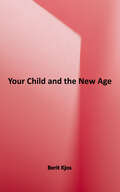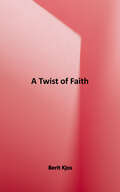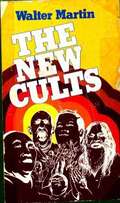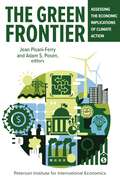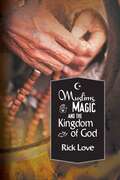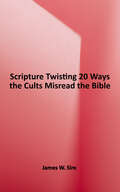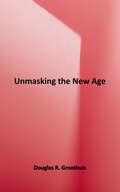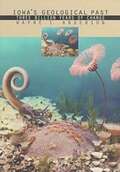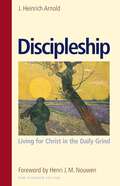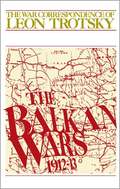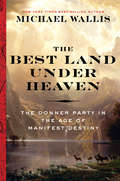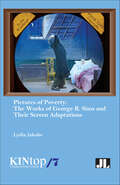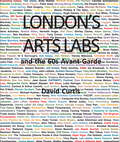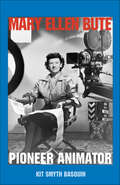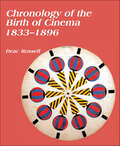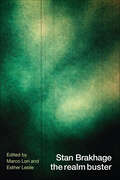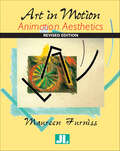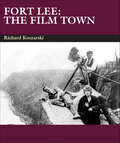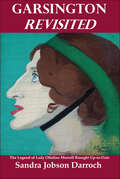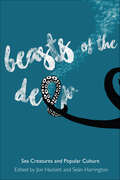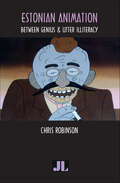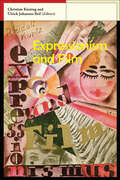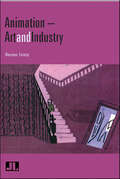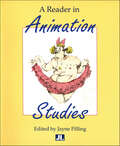- Table View
- List View
Your Child and the New Age
by Berit KjosThe purpose of this book is to expose New Age deception and to equip families to stand together in confident, loving resistance. It is not to condemn schools or media presentations. Countless wonderful teachers continue to bring good values to the classroom. Many books, movies, and television programs still reflect Judeo/Christian thinking. However, New Age thought and practices have entered the schools and the media to such an extent that none of our children are immune. While counterfeit spirituality may find more fertile ground in certain schools, it colors textbooks, television, and toys nationwide. It defies opposition, because it usually sounds good. Tailor-made to fit their human nature and Western culture, it offers whatever children want to hear, see, have, and be.
A Twist of Faith
by Berit KjosBerit Kjos is convinced that millions of women are traveling down cultural freeways to self-made spirituality. Why, she asks, have feminist myths and goddesses replaced biblical faith for many Christians who have embarked on journeys of self-discovery?
Martin Speaks Out On The Cults
by Walter MartinThis book has been used by Christians to equip them to share their faith effectively with cultists and to win those lost souls for the kingdom of God cultists have read this book and it will challenge them to investigate the claims of the true Jesus Christ of the Bible and to abandon the false Christ's of the cults.
The Green Frontier: Assessing the Economic Implications of Climate Action
by Jean Pisani-Ferry and Adam S. PosenAddressing climate change will entail major challenges for economic growth, employment, inflation, and public finances. Mitigating the impact of global warming will yield benefits and costs that are yet to be quantified and defined for the global economy and for nations, workers, households, and companies. The Green Frontier: Assessing the Economic Implications of Climate Action offers research originally presented at a major conference at the Peterson Institute for International Economics in June 2023 in Washington, DC, organized to shed light on this still unexplored field of study and recommend policies for the future.
Muslims, Magic And The Kingdom Of God: Church Planting Among Folk Muslims
by Rick LoveThis book combines a description of folk Islam, biblical perspectives, and strategies for church planting among Muslims. In his theory on Muslim evangelism, Love tackles the major issues of encountering spiritual powers, contextualization, and leadership development. Teachers of Islamic subjects and practitioners in Muslim countries enthusiastically welcome this book.
Scripture Twisting: 20 Ways The Cults Misread the Bible
by James W. SireHow often have you encountered some bizarre doctrine only to be stunned to hear a Bible verse quoted to support it? With new religious cults springing up almost daily and old ones growing rapidly, this is more and more common. How are they seemingly able to twist Scripture to mean something orthodox Christians have never believed it to mean in two thousand years? James Sire, author of The Universe Next Door and How to Read Slowly, has isolated twenty separate kinds of reading errors which are characteristically made by cultists as they interpret the Bible. He covers the full range from simple misquotation to complex argumentation which links one slightly eccentric interpretation to another, mixes in a few orthodox readings and ends with a conclusion totally foreign to the biblical world view. Sire also handles twisted translation, over specification, virtue by association, ignoring the context, and other flawed interpretations. A book to help us all become better readers of the Scriptures.
Unmasking the New Age
by Douglas GroothuisWhat is the New Age movement? Is it a conspiracy? What can Christians do about it? In the last ten years, the New Age has shifted out of the counterculture into the mainstream of society. Today its effects are felt in almost every aspect of life--medicine, politics, science, psychology and even religion. --Fortune 500 corporations routinely send their managers to New Age seminars to expand their minds and increase productivity. --Entertainer Shirley MacLaine has written two best-selling books that chronicle her conversion to the New Age. --Doctors and therapists increasingly employ healing techniques that are based on pantheistic principles. --Even advertisers on radio and television, in tune with New Age ideas, are telling us that we have unlimited potential. Douglas Groothuis explains how the New Age combines Eastern mysticism with Western optimism and why it has become so popular. His thorough, biblical analysis helps Christians know how to respond to this aggressive movement.
Iowa's Geological Past: Three Billion Years Of Change (Bur Oak Bks.)
by Wayne I. AndersonAn illustrated survey of the geological history of the state of Iowa, from the Precambrian through to the end of the Great Ice Age, written by Professor of Geology at the University of Northern Iowa.
Discipleship: Living For Christ In The Daily Grind
by Henri J. M. Nouwen J. Heinrich ArnoldArnold guides readers toward leading Christ-like lives amid the stress and strain of modern life. Perhaps the hardest thing about following Christ is translating our good intentions into deeds. Christ calls us, and we yearn to answer him, but time and again we lose resolve. Is discipleship really possible today? Many of the selections in this book offer answers to specific needs or problems. Others grapple with broader themes such as world suffering, salvation, and the coming of the kingdom of God. All of them pulsate with conviction and compassion, giving fresh hope to those who find themselves lonely or disheartened in the daily search to follow Christ. J. Heinrich Arnold served for many years as elder of the Bruderhof, a Christian communal movement. Discipleship contains writings, letters, and talks from his forty years of service as pastor, marriage counselor, educator, and parent.
The Balkan Wars (1912-13): The War Correspondence Of Leon Trotsky
by Leon Trotsky George Lavan WeissmanOn-the-spot analysis of national and social conflicts in the Balkans, written 80 years ago, sheds light on the conflicts shaking these countries today. Photos, maps, chronology, glossary, index.
The Best Land Under Heaven: The Donner Party In The Age Of Manifest Destiny
by Michael WallisLonglisted for the Andrew Carnegie Medal for Excellence Finalist for the Oklahoma Book Award A Publishers Weekly Holiday Guide History Pick “A book so gripping it can scarcely be put down.... Superb.” —New York Times Book Review "WESTWARD HO! FOR OREGON AND CALIFORNIA!" In the eerily warm spring of 1846, George Donner placed this advertisement in a local newspaper as he and a restless caravan prepared for what they hoped would be the most rewarding journey of a lifetime. But in eagerly pursuing what would a century later become known as the "American dream," this optimistic-yet-motley crew of emigrants was met with a chilling nightmare; in the following months, their jingoistic excitement would be replaced by desperate cries for help that would fall silent in the deadly snow-covered mountains of the Sierra Nevada. We know these early pioneers as the Donner Party, a name that has elicited horror since the late 1840s. With The Best Land Under Heaven, Wallis has penned what critics agree is “destined to become the standard account” (Washington Post) of the notorious saga. Cutting through 160 years of myth-making, the “expert storyteller” (True West) compellingly recounts how the unlikely band of early pioneers met their fate. Interweaving information from hundreds of newly uncovered documents, Wallis illuminates how a combination of greed and recklessness led to one of America’s most calamitous and sensationalized catastrophes. The result is a “fascinating, horrifying, and inspiring” (Oklahoman) examination of the darkest side of Manifest Destiny.
Pictures of Poverty: The Works of George R. Sims and Their Screen Adaptations (Kintop Studies In Early Cinema Ser.)
by Lydia JakobsFrom Charles Dickens's Oliver Twist to George Sims's How the Poor Live, illustrated accounts of poverty were en vogue in Victorian Britain. Poverty was also a popular subject on the screen, whether in dramatic retellings of well-known stories or in 'documentary' photographs taken in the slums. London and its street life were the preferred setting for George Robert Sims's rousing ballads and the numerous magic lantern slide series and silent films based on them. Sims was a popular journalist and dramatist, whose articles, short stories, theatre plays and ballads discussed overcrowding, drunkenness, prostitution and child poverty in dramatic and heroic episodes from the lives and deaths of the poor. Richly illustrated and drawing from many previously unknown sources, Pictures of Poverty is a comprehensive account of the representation of poverty throughout the Victorian period, whether disseminated in newspapers, illustrated books and lectures, presented on the theatre stage or projected on the screen in magic lantern and film performances. Detailed case studies reveal the intermedial context of these popular pictures of poverty and their mobility across genres. With versatile author George R. Sims as the starting point, this study explores the influence of visual media in historical discourses about poverty and the highly controversial role of the Victorian state in poor relief.
London's Arts Labs and the 60s Avant-Garde
by David CurtisThis is the story of two short-lived artist-run spaces that are associated with some of the most innovative developments in the arts in Britain in the late 1960s. The Drury Lane Arts Lab (1967–69) was home to the first UK screenings of Andy Warhol's twin-screen 3 hour film Chelsea Girls, challenging exhibitions (John and Yoko / John Latham / Takis / Roelof Louw), poetry and music (first UK performance of Erik Satie's 24-hour Vexations) and fringe theatre (People Show / Freehold / Jane Arden's Vagina Rex and the Gas Oven / Will Spoor Mime Theatre). The Robert Street 'New Arts Lab' (1969–71) housed Britain's first video workshop TVX, the London Filmmakers Co-op's first workshop and a 5-days-a-week cinema devoted to showing new work by moving-image artists (David Larcher / Malcolm Le Grice / Sally Potter / Carolee Schneemann / Peter Gidal). It staged J G Ballard's infamous Crashed Cars exhibition and John & Dianne Lifton's pioneering computer-aided dance/mime performances.The impact of London's Labs led to an explosion of new artist-led spaces across Britain. This book relates the struggles of FACOP (Friends of the Arts Council Operative) to make the case for these new kinds of space and these new art-forms and the Arts Council's hesitant response – in the context of a popular press already hostile to youth culture, experimental art and the 'underground'. With a Foreword by Andrew Wilson, Curator Modern & Contemporary British Art and Archives, Tate Gallery.
Mary Ellen Bute: Pioneer Animator
by Kit Smyth BasquinMary Ellen Bute: Pioneer Animator captures the personal and professional life of Mary Ellen Bute (1906–1983) one of the first American filmmakers to create abstract animated films in 1934, also one of the first Americans to use the electronic image of the oscilloscope in films starting in 1949, and the first filmmaker to interpret James Joyce's literature for the screen, Passages from James Joyce's Finnegans Wake, a live-action film for which she won a Cannes Film Festival Prize in 1965. Bute had an eye for talent and selected many creative people who would go on to be famous. She hired Norman McLaren to hand paint on film for the animation of her Spook Sport, 1939, before he left to head the animation department of the Canadian Film Board. She cast the now famous character actor Christopher Walken at age fourteen as the star of her short live-action film, The Boy Who Saw Through, 1958. Also, Bute enlisted Elliot Kaplan to compose the film score of her Finnegans Wake before he moved on to compose music for TV's Fantasy Island and Ironside. This biography drawn from interviews with Bute's family, friends, and colleagues, presents the personal and professional life of the filmmaker and her behind-the-scenes process of making animated and live action films.
Chronology of the Birth of Cinema, 1833–1896
by Deac RossellWritten from an international perspective, this account of the origins of the cinema begins in 1833 with the introduction of optical toys for reproducing movement and ends with a thorough examination of the first full year of projected moving pictures in 1896. Comprehensive and verifiable, with citations that support each individual entry, the book examines the events that culminated in the establishment of the moving picture world that was the dominant visual medium of the last century. Drawing on a range of international sources, this chronology is a readable, vivid account that corrects many longstanding errors in the story of moving pictures while at the same time recording the astounding diversity of ideas, apparatus, personalities, and exhibitions that turned a passing novelty into a major industry. Populated by dreamers, inventors, scientists, and entrepreneurs with widely different skills, interests, and backgrounds, the many origins of the cinema are all recorded here in a rich tapestry that has been woven with attention to the detailed shape and placement of each individual thread. The result is a fully- indexed reference that reflects the state of modern scholarship and should be useful over the long term as both a reference to the period of early cinema and as a starting point for further research.
Stan Brakhage the realm buster
by Marco Lori and Esther LeslieStan Brakhage's body of work counts as one of the most important within post-war avant-garde cinema, and yet it has rarely been given the attention it deserves. Over the years, though, diverse and original reflections have developed, distancing his figure little by little from critical categories. This collection of newly commissioned essays, plus some important reprinted work, queries some of the consensus on Brakhage's films. In particular, many of these essays revolve around the controversial issues of representation and perception.This project sets out from the assumption that Brakhage's art is articulated primarily through opposing tensions, which donate his figure and films an extraordinary depth, even as they evince fleetingness, elusivity and paradoxicality. This collection aims not only to clarify aspects of Brakhage's art, but also to show how his work is involved in a constant mediation between antinomies and opposites. At the same time, his art presents a multifaceted object endlessly posing new questions to the viewer, for which no point of entry or perspective is preferred in respect to the others. Acknowledging this, this volume hopes that the experience of his films will be revitalised.Featuring topics as diverse as the technical and semantic ambiguity of blacks, the fissures in mimetic representation of the 'it' within the 'itself' of an image, the film-maker as practical psychologist through cognitive theories, the critique of ocularcentrism by mingling sight with other senses such as touch, films that can actually philosophise in a Wittgensteinian way, political guilt and collusion in aesthetic forms, a disjunctive, reflexive, and phenomenological temporality realising Deleuze's image-time, and the echoes of Ezra Pound and pneumophantasmology in the quest of art as spiritual revelation; this book addresses not only scholars, but also is a thorough and thought-provoking introduction for the uninitiated. Contributors include: Nicky Hamlyn, Peter Mudie, Paul Taberham, Gareth Evans, Rebecca A. Sheehan, Christina Chalmers, Stephen Mooney and Marco Lori.
Art in Motion: Animation Aesthetics
by Maureen FurnissArt in Motion, Revised Edition is the first comprehensive examination of the aesthetics of animation in its many forms. It gives an overview of the relationship between animation studies and media studies, then focuses on specific aesthetic issues concerning flat and dimensional animation, full and limited animation, and new technologies. A series of studies on abstract animation, audiences, representation, and institutional regulators is also included.
Fort Lee: The Film Town (1904-2004)
by Richard KoszarskiDuring the 1910s, motion pictures came to dominate every aspect of life in the suburban New Jersey community of Fort Lee. During the nickelodeon era, D.W. Griffith, Mary Pickford, and Mack Sennett would ferry entire acting companies across the Hudson to pose against the Palisades. Theda Bara, "Fatty" Arbuckle, and Douglas Fairbanks worked in the rows of great greenhouse studios that sprang up in Fort Lee and the neighboring communities. Tax revenues from studios and laboratories swelled municipal coffers.Then, suddenly, everything changed. Fort Lee, the film town once hailed as the birthplace of the American motion picture industry, was now the industry's official ghost town. Stages once filled to capacity by Paramount and Universal were leased by independent producers or used as paint shops by scenic artists from Broadway. Most of Fort Lee's film history eventually burned away, one studio at a time.Richard Koszarski re-creates the rise and fall of Fort Lee filmmaking in a remarkable collage of period news accounts, memoirs, municipal records, previously unpublished memos and correspondence, and dozens of rare posters and photographs—not just film history, but a unique account of what happened to one New Jersey town hopelessly enthralled by the movies.Distributed for John Libbey Publishing
Garsington Revisited: The Legend of Lady Ottoline Morrell Brought Up-to-Date
by Sandra Jobson DarrochLady Ottoline Morrell was the foremost host of the Bloomsbury set, offering sustenance and friendship to Virginia Woolf, Vanessa Bell, TS Eliot, DH Lawrence, Duncan Grant and her lover Bertrand Russell, to name but a few. This book is a revised and updated edition of the author's original biography of Ottoline first published in 1975 worldwide. It has been updated, with vignettes about her sources, including lunch at ?xml:namespace prefix = st1 ns = "urn:schemas-microsoft-com:office:smarttags" / Charleston with Duncan Grant, and a ship's tumbler of sherry with David Garnett as a prelude to discussing "skeletons in Ottoline's cupboard"). Her sources in Texas where she read more than 8,000 letters to Ottoline including 2,500 letters from Bertrand Russell, can now be located in new footnotes. Darroch remains as impressed as ever by Ottoline's courage and determination to forgo the comfortable life of an aristocrat to mix with – and champion – some of the 20th century's leading artists and writers. The definitive biography.
Beasts of the Deep: Sea Creatures and Popular Culture
by Jon Hackett and Seán HarringtonBeasts of the Deep: Sea Creatures and Popular Culture offers its readers an in-depth and interdisciplinary engagement with the sea and its monstrous inhabitants; through critical readings of folklore, weird fiction, film, music, radio and digital games. Within the text there are a multitude of convergent critical perspectives used to engage and explore fictional and real monsters of the sea in media and folklore. The collection features chapters from a variety of academic perspectives; post- modernism, psychoanalysis, industrial-organisational analysis, fandom studies, sociology and philosophy are featured. Under examination are a wide range of narratives and media forms that represent, reimagine and create the Kraken, mermaids, giant sharks, sea draugrs and even the weird creatures of H.P. Lovecraft.Beasts of the Deep offers an expansive study of our sea-born fears and anxieties, that are crystallised in a variety of monstrous forms. Repeatedly the chapters in the collection encounter the contemporary relevance of our fears of the sea and its inhabitants – through the dehumanising media depictions of refugees in the Mediterranean to the encroaching ecological disasters of global warming, pollution and the threat of mass marine extinction.
Estonian Animation: Between Genius & Utter Illiteracy
by Chris RobinsonEver wonder why Estonian animation features so many carrots or why cows often perform pyramids? Well, neither question is answered in Chris Robinson's new book, Estonian Animation. Robinson's frank, humorous, and thoroughly researched book traces the history of Estonia's acclaimed animation scene from early experiments in the 1930s to the creation of puppet (Nukufilm) and cel (Joonisfilm) animation studios during the Soviet era, as well as Estonia's surprising international success during the post-Soviet era. In addition, Robinson writes about the discovery of films by four 1960s animation pioneers who, until the release of this book, had been unknown to most Estonian and international animation historians.
Expressionism and Film
by Rudolf KurtzExpressionism and Film, originally published in German in 1926, is not only a classic of film history, but also an important work from the early phase of modern media history. Written with analytical brilliance and historical vision by a well-known contemporary of the expressionist movement, it captures Expressionism at the time of its impending conclusion—as an intersection of world view, resoluteness of form, and medial transition. Though one of the most frequently-cited works of Weimar culture, Kurtz's groundbreaking work, which is on a par with Siegfried Kracauer's From Caligari to Hitler and Lotte Eisner's The Haunted Screen, has never been published in English. Its relevance and historical contexts are analyzed in a concise afterword by the Swiss scholars Christian Kiening and Ulrich Johannes Beil.
Animation: Art and Industry
by Maureen FurnissAnimation—Art and Industry is an introductory reader covering a broad range of animation studies topics, focusing on both American and international contexts. It provides information about key individuals in the fields of both independent and experimental animation, and introduces a variety of topics relevant to the critical study of media—censorship, representations of gender and race, and the relationship between popular culture and fine art. Essays span the silent era to the present, include new media such as web animation and gaming, and address animation made using a variety of techniques.
A Reader in Animation Studies
by Jayne PillingCartoons—both from the classic Hollywood era and from more contemporary feature films and television series—offer a rich field for detailed investigation and analysis. Contributors draw on theories and methodology from film, television, and media studies, art history and criticism, and feminism and gender studies.
